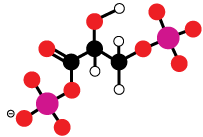Page outline
1. Introduction
Let’s begin with an interactive reading to review photosynthesis as a whole, and what you’ve already learned about the Calvin Cycle.
[qwiz qrecord_id=”sciencemusicvideosMeister1961-PSN, Calvin Cycle Overview”]
[h]Photosynthesis and Calvin Cycle Overview
[i]
[q dataset_id=”SMV_PSN_Part 5 (Calvin Cycle) Introduction|171ddd77ccc756″ question_number=”1″]We’ve seen so far that photosynthesis involves two phases. The one indicated by “II” is called the [hangman] cycle.
[c]Q2Fsdmlu
Cg==[Qq]
[q dataset_id=”SMV_PSN_Part 5 (Calvin Cycle) Introduction|171d9e9a8bbb56″ question_number=”2″]The Calvin cycle takes the outputs of the light reactions, and along with carbon dioxide, uses them as inputs. Which number indicates carbon dioxide?
[textentry single_char=”true”]
[c]Ng ==[Qq]
[f]WWVzLiDigJw24oCdIGlzIGNhcmJvbiBkaW94aWRl[Qq]
[c]Kg==[Qq]
[f]Tm8uIEhlcmUmIzgyMTc7cyBhIGhpbnQuIEZpbmQgYW4gYXJyb3cgdGhhdCYjODIxNztzIGdvaW5nIGludG8gdGhlIENhbHZpbiBjeWNsZSwgYnV0IHdoaWNoIGlzIG5vdCBvbmUgb2YgdGhlIG91dHB1dHMgb2YgdGhlIGxpZ2h0IHJlYWN0aW9ucy4=
Cg==[Qq]
[q dataset_id=”SMV_PSN_Part 5 (Calvin Cycle) Introduction|171d6211569356″ question_number=”3″]Carbon dioxide, at “6,” can be considered the external input of the Calvin cycle. An internal input includes the reduced mobile electron carrier [hangman], which is shown at “5.”
[c]TkFEUEg=
Cg==[Qq]
[q dataset_id=”SMV_PSN_Part 5 (Calvin Cycle) Introduction|171d2588216b56″ question_number=”4″]One of the internal inputs of the Calvin cycle is the reduced mobile electron carrier NADPH, shown at “5” below. The other input is [hangman], indicated by “4.”
[c]QVRQ
Cg==[Qq]
[q dataset_id=”SMV_PSN_Part 5 (Calvin Cycle) Introduction|171ce8feec4356″ question_number=”5″]While the light reactions occur in the thylakoid sacs, the Calvin cycle occurs in the [hangman].
[c]c3Ryb21h
Cg==[Qq]
[q dataset_id=”SMV_PSN_Part 5 (Calvin Cycle) Introduction|171ca7cd9f5356″ question_number=”6″]Which letter or number shows the structures that carry out the light reactions?
[textentry single_char=”true”]
[c]YQ ==[Qq]
[f]WWVzLiBUaGUgbGV0dGVyIOKAnGHigJ0gaW5kaWNhdGVzIHRoZSB0aHlsYWtvaWRz[Qq]
[c]SQ ==[Qq]
[f]WWVzLiAmIzgyMjA7SSYjODIyMTsgc2hvd3MgYSBzdGFjayBvZiB0aHlsYWtvaWRzIChhbmQgaW5kaWNhdGVzIHRoZSBsaWdodCByZWFjdGlvbnMpLg==[Qq]
[c]Kg==[Qq]
[f]Tm8uIEhlcmUmIzgyMTc7cyBhIGhpbnQuIFRoZSBsaWdodCByZWFjdGlvbnMgb2NjdXIgaW4gdGhlIHRoeWxha29pZCBzYWNzLCB3aGljaCBhcmUgdGlueSBvdmFsIHN0cnVjdHVyZXMgd2l0aGluIHRoZSBjaGxvcm9wbGFzdCwgb3JnYW5pemVkIGludG8gc3RhY2tzLg==
Cg==[Qq]
[q dataset_id=”SMV_PSN_Part 5 (Calvin Cycle) Introduction|171c68f05e4756″ question_number=”7″]Which letter or number shows the area in the chloroplast where the Calvin cycle takes place? (Note: don’t enter a roman numeral)
[textentry single_char=”true”]
[c]Yg ==[Qq]
[f]WWVzLiBMZXR0ZXIg4oCcYuKAnSBpbmRpY2F0ZXMgdGhlIHN0cm9tYSwgd2hpY2ggaXMgd2hlcmUgdGhlIENhbHZpbiBjeWNsZSB0YWtlcyBwbGFjZS4=[Qq]
[c]Kg==[Qq]
[f]Tm8uIEhlcmUmIzgyMTc7cyBhIGhpbnQuIFRoZSBDYWx2aW4gY3ljbGUgb2NjdXJzIGluIHRoZSBlcXVpdmFsZW50IG9mIHRoZSBjeXRvcGxhc20gb2YgdGhlIGNobG9yb3BsYXN0JiM4MjExO3RoZSBmbHVpZCB0aGF0IGlzIGJldHdlZW4gdGhlIHRoeWxha29pZHMgYW5kIHRoZSBjaGxvcm9wbGFzdCYjODIxNztzIGlubmVyIG1lbWJyYW5lLg==
Cg==[Qq]
[q dataset_id=”SMV_PSN_Part 5 (Calvin Cycle) Introduction|171c256b057356″ question_number=”8″]To the extent that any biological process can be said to have a purpose, then the purpose of photosynthesis, from a plant’s perspective, is to create
[textentry single_char=”true”]
[c]Nw ==[Qq]
[f]WWVzLiBMZXR0ZXIg4oCcN+KAnSBpbmRpY2F0ZXMgY2FyYm9oeWRyYXRlLiBTeW50aGVzaXppbmcgY2FyYm9oeWRyYXRlcyBpcywgZnJvbSBhIHBsYW50JiM4MjE3O3MgcGVyc3BlY3RpdmUsIHRoZSBwdXJwb3NlIG9mIHBob3Rvc3ludGhlc2lzLg==[Qq]
[c]Kg==[Qq]
[f]Tm8uIEhlcmUmIzgyMTc7cyBhIGhpbnQuIFRoZSBwdXJwb3NlIG9mIHBob3Rvc3ludGhlc2lzLCBmcm9tIGEgcGxhbnQmIzgyMTc7cyBwZXJzcGVjdGl2ZSwgaXMgdG8gY3JlYXRlIHN1Z2FycyB0aGF0IGNhbiBiZSB1c2VkIGZvciBncm93dGggYW5kIGVuZXJneS4gV2hpY2ggcGFydCBvZiB0aGUgZGlhZ3JhbSBjb3VsZCByZXByZXNlbnQgYSBzdWdhcj8=[Qq]
[x][restart]
[/qwiz]
2. The Calvin Cycle
Thus far in this series of tutorials, our vision of the Calvin Cycle has involved the diagram that you just worked with in the quiz above. By the end of this tutorial, you should be able to explain what’s going on in the diagram below, which shows the inputs, outputs, and key intermediate compounds of the Calvin cycle in more detail.
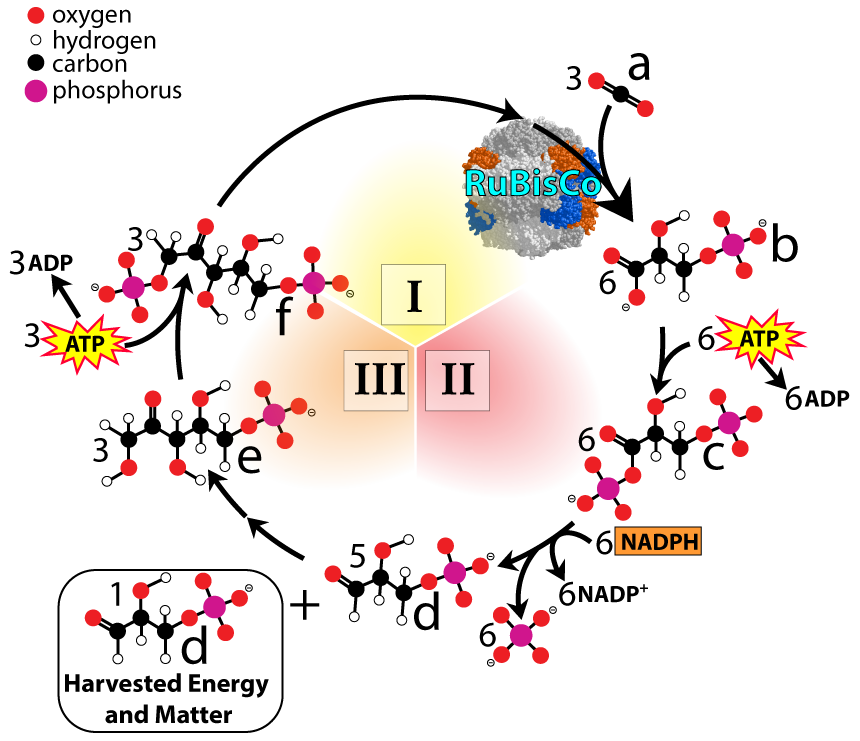 Note the legend on the top left, which tells you how to identify the carbon, hydrogen, oxygen, and phosphorus atoms that make up the molecules involved in the cycle.
Note the legend on the top left, which tells you how to identify the carbon, hydrogen, oxygen, and phosphorus atoms that make up the molecules involved in the cycle.- The Roman numbers I, II, and III indicate the three phases of the Calvin Cycle.
- The letters “a” through “f” next to the structural formulas in the diagram represent molecules involved in the cycle (and you’ll learn their names in what follows).
- The numbers “1,” “3,” “5,” or “6” next to the structural formulas indicate the number of molecules. For example, find the letter “a” in the top right of the diagram (at about 1 o’clock), The “3” next to the structural formula for carbon dioxide indicates that there are three carbon dioxide molecules entering the cycle.
Why does the number of molecules matter? It’s because the Calvin cycle is how matter enters the biosphere. Only by following the number of molecules (and atoms) will we be able to see that happening.
Finally, you might remember why the cycle is called the Calvin Cycle. It’s named for the University of California biochemist Melvin Calvin, who won a Nobel Prize for discovering how the cycle works in 1961. Calvin’s collaborator in this work was Andrew Benson, and the cycle is sometimes called the Cavin-Benson Cycle. It’s also referred to as the light-independent reactions of photosynthesis.
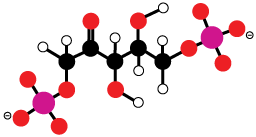
Phase 1: Carbon Fixation
 Let’s start by looking at how matter enters the Calvin Cycle. That happens through carbon fixation, which is Phase 1 of the cycle.
Let’s start by looking at how matter enters the Calvin Cycle. That happens through carbon fixation, which is Phase 1 of the cycle.
Start by finding the molecule next to “f.” This is ribulose bisphosphate, also known as RuBP. RuBP consists of the 5-carbon sugar ribose with two phosphate groups attached to it. So, the cycle starts with three molecules of RuBP, for a total of 15 carbon atoms in the cycle.
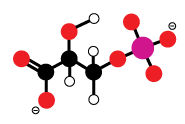
Now, follow the arrow from RuBP to a space-filling model of an enzyme called RuBisCo. “RuBisCo” is an abbreviation for ribulose bisphosphate carboxylate. RuBisCo’s function is to take RuBP (Ribulose Bisphosphate) and combine it with carbon dioxide, shown at “a.” Keeping track of our carbons, what’s happening is that three molecules of RuBP are going to be combined with three molecules of carbon dioxide. Since RuBP has five carbon atoms, and carbon dioxide has one, you might expect that the result would be three, six-carbon molecules. That is what happens, but that six-carbon molecule is so unstable that it immediately dissociates into two three-carbon molecules. Because three of these six-carbon molecules have split themselves in half, we now have six three-carbon molecules called 3-phosphoglycerate, shown at “b.” That’s a total of 18 carbon atoms present at this point in the cycle.
To connect this to your existence, consider this: carbon fixation is how gaseous carbon dioxide gets pulled into living matter. It’s the basis of plant growth, which forms the foundation of almost every ecosystem on Earth. Every carbon atom in your body was once gaseous carbon dioxide in the air. Then it was in a plant. And now, either through a direct pathway (you ate the plant) or an indirect one (you ate an animal that ate the plant), it’s in you.
Phase II: Energy Investment and Harvest
 In Phase II of the Calvin Cycle, the three-carbon molecule 3-phosphoglycerate gets phosphorylated and reduced. Here’s where the outputs of the light reactions (ATP and NADPH) become inputs for the Calvin Cycle.
In Phase II of the Calvin Cycle, the three-carbon molecule 3-phosphoglycerate gets phosphorylated and reduced. Here’s where the outputs of the light reactions (ATP and NADPH) become inputs for the Calvin Cycle.
In step “c,” an enzyme takes a phosphate from ATP and places it onto 3-phosphoglycerate, creating 1,3-bisphosphoglycerate. In step “d,” another enzyme takes 1,3-bisphosphoglycerate and reduces it. In this step, energetic electrons (and hydrogen) from NADPH are transferred to 1,3-bisphosphoglycerate, which becomes glyceraldehyde-3-phosphate, or G3P. You can see the effects of this reduction by counting the number of hydrogen atoms in each compound. Which compound has more?
|
|
|
G3P is the harvestable product of the Calvin Cycle. Note that from the moment that followed carbon fixation, we’ve had six, three-carbon molecules (for a total of 18 carbon atoms). Now the cell is going to harvest some of this reduced, energized G3P. When farmers harvest their crops, they remove the plants from their fields and use them (eating them or selling them). The cell will now do a similar thing, using the chemical energy in this three-carbon G3P for energy, or using the atoms for growth. That harvest is indicated on the lower left side of the Calvin Cycle diagram.
Phase III: Regeneration of RuBP
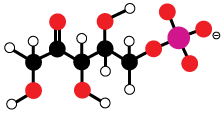
 Removing a G3P from the cycle leaves us with 15 carbon atoms: there were 18 carbons immediately following the carbon fixation phase, and we just removed three carbons in G3P. To prepare to run the cycle again, the chloroplast needs to regenerate the starting compound RuBP, and that’s what Phase III is all about. A series of enzymes take the five, three-carbon G3P molecules that the Calvin Cycle is left with after one of the G3Ps is harvested, and reorganizes them into three, five-carbon molecules. Note that we still have 15 carbon atoms.
Removing a G3P from the cycle leaves us with 15 carbon atoms: there were 18 carbons immediately following the carbon fixation phase, and we just removed three carbons in G3P. To prepare to run the cycle again, the chloroplast needs to regenerate the starting compound RuBP, and that’s what Phase III is all about. A series of enzymes take the five, three-carbon G3P molecules that the Calvin Cycle is left with after one of the G3Ps is harvested, and reorganizes them into three, five-carbon molecules. Note that we still have 15 carbon atoms.
This five-carbon molecule is called ribulose-5-phosphate (at “e” in the diagram, and also at the right). In terms of structure, ribulose-5-phosphate is very close to RuBP: it’s just missing one phosphate. Enzymes solve this problem by taking three ATPs, removing their phosphates, and attaching them to ribulose-5-phosphate. This re-creates the three molecules of 5-carbon RuBP needed for another round of carbon fixation.
What’s the take-away?
 If you’re supplied with a diagram like the one we’ve been using, you should be able to explain where carbon fixation, reductions, phosphorylations, and rearrangements are happening. As you do this, the names of the intermediates are not important: you just need to remember two compounds: “RuBP” and “G3P.”
If you’re supplied with a diagram like the one we’ve been using, you should be able to explain where carbon fixation, reductions, phosphorylations, and rearrangements are happening. As you do this, the names of the intermediates are not important: you just need to remember two compounds: “RuBP” and “G3P.”
Here are the key points to remember:
- During the Calvin cycle, the enzyme Rubisco carries out carbon fixation, combining carbon dioxide with the Calvin Cycle’s starting and ending compound, RuBP.
- This is an endergonic (energy-requiring) process and it’s powered by the high-energy products of the light reactions, ATP and NADPH.
- Because it’s chemically powered by ATP and NADPH, the Calvin cycle doesn’t need light to proceed. That’s why you’ll see it referred to as the “light-independent reactions,” or even the “dark reactions.”
- The harvestable product is the three-carbon sugar G3P, also known as glyceraldehyde-3-phosphate.
2a. Calvin Cycle Rap
3. The Calvin Cycle: Checking Understanding
Got it? Try the quiz below.
[qwiz random = “true” width:700px” qrecord_id=”sciencemusicvideosMeister1961-Calvin Cycle Checking Understanding (2.0)”]
[h]Calvin Cycle: Checking Understanding
[i]
[q labels = “top” dataset_id=”SMV_PSN_Calvin Cycle Quiz|171a2e80fd1356″ question_number=”1″]
[l]Carbon Dioxide
[fx] No, that’s not correct. Please try again.
[f*] Excellent!
[l]Carbon Fixation Phase
[fx] No. Please try again.
[f*] Excellent!
[l]Energy Investment Phase
[fx] No. Please try again.
[f*] Excellent!
[l]G3P
[fx] No. Please try again.
[f*] Great!
[l]Phosphorylation
[fx] No. Please try again.
[f*] Great!
[l]Reduction
[fx] No, that’s not correct. Please try again.
[f*] Correct!
[l]RuBP
[fx] No, that’s not correct. Please try again.
[f*] Good!
[l]RuBP Regeneration Phase
[fx] No. Please try again.
[f*] Great!
[q dataset_id=”SMV_PSN_Calvin Cycle Quiz|1719f69fdfb356″ question_number=”2″]After carbon dioxide is combined with RuBP, the six carbon product immediately dissociates into which of the molecules shown below?
[textentry single_char=”true”]
[c]Yg ==[Qq]
[f]WWVzLiBMZXR0ZXIg4oCcYuKAnSBpbmRpY2F0ZXMgdGhlIHRocmVlLWNhcmJvbiBtb2xlY3VsZSB0aGF0IGFwcGVhcnMgaW4gdGhlIENhbHZpbiBjeWNsZSBpbW1lZGlhdGVseSBmb2xsb3dpbmcgY2FyYm9uIGZpeGF0aW9uLg==[Qq]
[c]Kg==[Qq]
[f]Tm8uIEhlcmUmIzgyMTc7cyBhIGhpbnQuIFVzZSB0aGUgbGVnZW5kICh1cHBlciByaWdodCkgdG8gZmlndXJlIG91dCB3aGljaCBtb2xlY3VsZSBpcyBjYXJib24gZGlveGlkZS4gUmlnaHQgbmVhcmJ5LCB5b3UmIzgyMTc7bGwgZmluZCB5b3VyIGFuc3dlci4=
Cg==[Qq]
[q dataset_id=”SMV_PSN_Calvin Cycle Quiz|1719bebec25356″ question_number=”3″]Which letter in the diagram below indicates RuBP, the starting and ending compound in the Calvin cycle?
[textentry single_char=”true”]
[c]Zg ==[Qq]
[f]WWVzLiBMZXR0ZXIg4oCcZuKAnSBpbmRpY2F0ZXMgUnVCUCwgdGhlIENhbHZpbiBjeWNsZSYjODIxNztzIHN0YXJ0aW5nIGFuZCBlbmRpbmcgY29tcG91bmQ=[Qq]
[c]Kg==[Qq]
[f]Tm8uIEhlcmUmIzgyMTc7cyBhIGhpbnQuIFVzZSB0aGUgbGVnZW5kICh1cHBlciByaWdodCkgdG8gZmlndXJlIG91dCB3aGljaCBtb2xlY3VsZSBpcyBjYXJib24gZGlveGlkZS4gUnVCUCBpcyB0aGUgbW9sZWN1bGUgdGhhdCBnZXRzIGNvbWJpbmVkIHdpdGggY2FyYm9uIGRpb3hpZGUgYXMgdGhlIENhbHZpbiBjeWNsZSBiZWdpbnMu
Cg==[Qq]
[q dataset_id=”SMV_PSN_Calvin Cycle Quiz|17197d8d756356″ question_number=”4″]Which letter in the diagram below shows a molecule that results from the chemical reduction that occurs within the Calvin cycle?
[textentry single_char=”true”]
[c]ZA ==[Qq]
[f]WWVzLiBMZXR0ZXIg4oCcZOKAnSBpbmRpY2F0ZXMgRzNQLCB3aGljaCByZXN1bHRzIHdoZW4gY29tcG91bmQgJiM4MjIwO2MmIzgyMjE7IGdldHMgcmVkdWNlZCwgcmVjZWl2aW5nIGVsZWN0cm9ucyBhbmQgaHlkcm9nZW4gZnJvbSBOQURQSC4=[Qq]
[c]Kg==[Qq]
[f]Tm8uIEhlcmUmIzgyMTc7cyBhIGhpbnQuIFRoZSBiaW9sb2dpY2FsIHJlZHVjdGlvbnMgaW4gdGhlIENhbHZpbiBjeWNsZSBpbnZvbHZlIGVsZWN0cm9ucyBhbmQgaHlkcm9nZW5zIHRoYXQgYXJlIGNvbnRyaWJ1dGVkIGJ5IE5BRFBILiBGaW5kIE5BRFBILCBhbmQgeW91JiM4MjE3O2xsIGhhdmUgeW91ciBhbnN3ZXIu
Cg==[Qq]
[q dataset_id=”SMV_PSN_Calvin Cycle Quiz|171945ac580356″ question_number=”5″]Which of the phases of the Calvin cycle involves carbon fixation?
[c]SSDCoC DCoCA=[Qq][c]SUkgwqAgwqAg[Qq][c]SUlJ
Cg==[Qq][f]WWVzLiBQaGFzZSBJIG9mIHRoaXMgQ2FsdmluIGN5Y2xlIGRpYWdyYW0gaW52b2x2ZXMgY2FyYm9uIGZpeGF0aW9uLg==[Qq]
[f]Tm8uIFRoaXMgaXMgdGhlIGVuZXJneSBpbnZlc3RtZW50IHBoYXNlLiBUaGVyZSBhcmUgcmVkdWN0aW9ucyBhbmQgcGhvc3Bob3J5bGF0aW9ucywgYnV0IG5vIGNhcmJvbiBmaXhhdGlvbi4gTG9vayBmb3IgYSBwaGFzZSB3aGVyZSBjYXJib24gaXMgY29taW5nIGludG8gdGhlIGN5Y2xlLg==[Qq]
[f]Tm8uIFRoaXMgaXMgdGhlIFJ1QlAgcmVnZW5lcmF0aW9uIHBoYXNlLiBMb29rIGZvciBhIHBoYXNlIHdoZXJlIGNhcmJvbiBpcyBjb21pbmcgaW50byB0aGUgY3ljbGUu
Cg==[Qq]
[q dataset_id=”SMV_PSN_Calvin Cycle Quiz|17190b772ebf56″ question_number=”6″]Which of the phases of the Calvin cycle shown below involves energy investment?
[c]SSDCoCDCoCA=[Qq][c]SUkgwq AgwqAg[Qq][c]SUlJ
Cg==[Qq][f]Tm8uIFBoYXNlIEkgb2YgdGhpcyBDYWx2aW4gY3ljbGUgZGlhZ3JhbSBpbnZvbHZlcyBjYXJib24gZml4YXRpb24uIExvb2sgZm9yIHRoZSBwaGFzZSB3aGVyZSBlbmVyZ3kgdHJhbnNmZXIgbW9sZWN1bGVzIChzdWNoIGFzIEFUUCBhbmQgTkFEUEgpIGFyZSBjb252ZXJ0ZWQgaW50byBsb3dlci1lbmVyZ3kgZm9ybXMu[Qq]
[f]WWVzLiBUaGlzIGlzIHRoZSBlbmVyZ3kgaW52ZXN0bWVudCBwaGFzZS4gVGhlcmUgYXJlIHJlZHVjdGlvbnMgYW5kIHBob3NwaG9yeWxhdGlvbnMsIGJvdGggb2Ygd2hpY2ggYWRkIGVuZXJneSB0byB0aGUgbW9sZWN1bGVzIGluIHRoZSBDYWx2aW4gY3ljbGUu[Qq]
[f]Tm8uIFRoaXMgaXMgdGhlIFJ1QlAgcmVnZW5lcmF0aW9uIHBoYXNlLiBMb29rIGZvciB0aGUgcGhhc2Ugd2hlcmUgZW5lcmd5IHRyYW5zZmVyIG1vbGVjdWxlcyAoc3VjaCBhcyBBVFAgYW5kIE5BRFBIKSBhcmUgY29udmVydGVkIGludG8gbG93ZXItZW5lcmd5IGZvcm1zLg==
Cg==[Qq]
[q dataset_id=”SMV_PSN_Calvin Cycle Quiz|1718d396115f56″ question_number=”7″]Which of the phases of the Calvin cycle shown below involves regeneration of RuBP?
[c]SSDCoCDCoCA=[Qq][c]SUkgwqAgwqAg[Qq][c]SU lJ
Cg==[Qq][f]Tm8uIFBoYXNlIEkgb2YgdGhpcyBDYWx2aW4gY3ljbGUgZGlhZ3JhbSBpbnZvbHZlcyBjYXJib24gZml4YXRpb24uIExvb2sgZm9yIGEgcGhhc2Ugd2hlcmUgdGhlIHN0YXJ0aW5nIGNvbXBvdW5kICh0aGUgNSBjYXJib24gbW9sZWN1bGUgUnVCUCkgaXMgYmVpbmcgcmVnZW5lcmF0ZWQu[Qq]
[f]Tm8uIFRoaXMgaXMgdGhlIGVuZXJneSBpbnZlc3RtZW50IHBoYXNlLiBMb29rIGZvciBhIHBoYXNlIHdoZXJlIHRoZSBzdGFydGluZyBjb21wb3VuZCAodGhlIDUgY2FyYm9uIG1vbGVjdWxlIFJ1QlApIGlzIGJlaW5nIHJlZ2VuZXJhdGVkLg==[Qq]
[f]WWVzLiBUaGlzIGlzIHRoZSBSdUJQIHJlZ2VuZXJhdGlvbiBwaGFzZS4=[Qq]
[q]In the diagram below, compound “a” is [hangman] [hangman].
[c]Y2FyYm9u[Qq]
[c]ZGlveGlkZQ==[Qq]
[q]In the diagram below, the acronym for compound “f” is [hangman], and the acronym for compound “d” is [hangman].
[c]UnVCUA==[Qq]
[c]RzNQ[Qq]
[q]In the diagram below, Phase I is [hangman] [hangman], and phase II is [hangman] [hangman].
[c]Y2FyYm9u[Qq]
[c]Zml4YXRpb24=[Qq]
[c]ZW5lcmd5[Qq]
[c]aW52ZXN0bWVudA==[Qq]
[x][restart]
[/qwiz]
What’s next?
This is the last tutorial about AP Bio Topic 3.4, Photosynthesis. Proceed to a cumulative review of all of AP Bio Unit 3.

